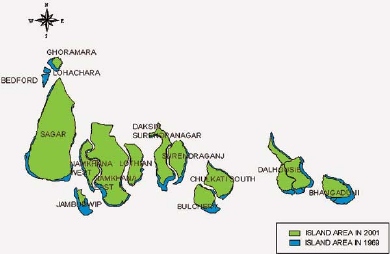R.I.P. Lohachara
 In case you haven’t already noticed, here’s a little landmark in the unfolding drama of greenhouse warming.
In case you haven’t already noticed, here’s a little landmark in the unfolding drama of greenhouse warming.
Lohachara, an island in the Sundarban island chain, located in the delta of the Ganges and Brahmaputra rivers — an island where 10,000 people once lived — has sunk completely beneath the rising Indian Ocean.
 The island’s final disappearance was noted two months ago by researchers at Jadavpur University, who had been examining satellite photos of the islands. The researchers attributed the disappearance to a rising sea level, mostly caused by global warming.
The island’s final disappearance was noted two months ago by researchers at Jadavpur University, who had been examining satellite photos of the islands. The researchers attributed the disappearance to a rising sea level, mostly caused by global warming.
This would make Lohachara the first inhabited island to have disappeared completely for this reason. A landmark indeed!
But the island’s inhabitants actually abandoned it twenty-two years ago, when the island had sunk so low that its inhabited parts were no longer habitable. So the vision you may have been momentarily entertaining — of rising waters engulfing villages just as the flood of anti-war sentiment hit Congress — isn’t really tenable.
And naturally, the details of this event have provoked some controversy.
Global warming deniers assert that the disappearance of Lohachara, and of the southern parts of nearly all the other Sundarban islands, is due to erosion, not climate change.
But what the arguments of the deniers leaves unanswered is the question of why erosion should so suddenly become dominant in the region now, after thousands of years in which the islands were being built up by the Ganges and Brahmaputra rivers faster than erosion could wash them away.
The sediment being carried by the Ganges and Brahmaputra rivers is increasing, not decreasing, due to deforestation in the Himalayan regions where those rivers arise. Logically this should mean that the islands would be growing, not shrinking.
Anyway, here’s some of what’s due to vanish as the oceans continue to rise: Much of Florida, including the Everglades with its endangered species and all of metro Miami. Nearly all of Louisiana, including the whole Cajun world. The White House, in Washington D.C. (though not until after Bush decamps). Manhattan.
It’ll be interesting to see if the deniers attribute these disappearances, too, to erosion.
Sources: The earliest report on Lohachara’s disappearance that I have seen was written by Subhra Priyadarshini, and appeared in the Calcutta Telegraph, October 29, 2006. An article on the fate of the Lohachara refugees, by Mohammed Safi Shamsi, appeared two days later in Kolkata Newsline, October 31, 2006.
Lohachara’s disappearance came to the attention of the Western world via an article by Geoffrey Lean in the British newspaper, The Independent, December 24, 2006. Blog articles by global warming deniers can be found here and here.





Reader Comments